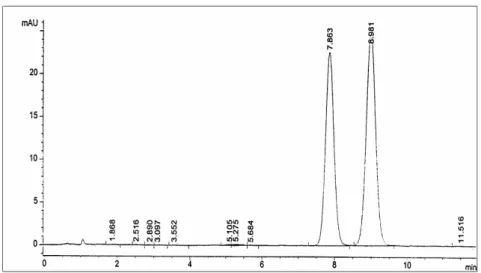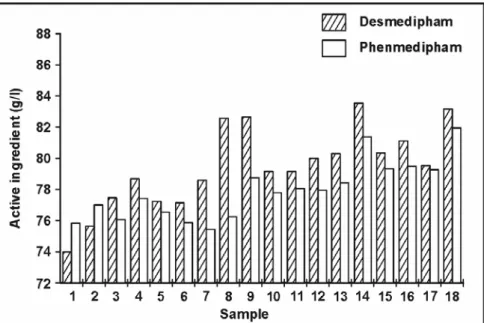UDC 543.544.5 : 543.641 : 632.954 APTEFF, 35, 1-280 (2004) BIBLID: 1450–7188 (2004) 35, 193-198 Original scientific paper
DETERMINATION OF PHENMEDIPHAM AND DESMEDIPHAM IN A COMMERCIAL HERBICIDE BY HIGH PERFORMANCE
LIQUID CHROMATOGRAPHY
Eva S. Lončar, Petar P. Sekulić, Tijana M. Zeremski-Škorić, Radomir V. Malbaša and Ljiljana A. Kolarov
Betanal AM-11 is the herbicide that is using to control one-year old weeds with wide leafs in sugar beet fields. Active ingredients of the herbicide are phenmedipham and des-medipham. Commercial emulsifiable concentrate (EC) contains 80 g/L ± 10% of each ac-tive compound. We applied high performance liquid chromatography (HPLC) with diode array detector (DAD) at 254 nm for the determination of phenmedipham and desme-dipham in commercial samples of Betanal AM-11. This method involves reversed-phase separation of the components on C-18 bonded silica with methanol-water (51+49, v/v) as the eluent. The procedure was highly selective and reproducible and can be success-fully used in determining contents of phenmedipham and desmedipham on micro and macro levels.
KEYWORDS:Phenmedipham; desmedipham; HPLC-DAD; determination
INTRODUCTION
Phenmedipham (PMP) and desmedipham (DMP) are widely used as selective herbi-cides for broad leaf weed control in beet crops, especially in sugar beet crops. Crops are treated at temperatures bellow 20°C, when beet has 2 to 3 straight leafs and weeds has 1 to 3 leafs. The Herbicide Betanal AM-11, with active ingredients phenmedipham and des-medipham, is produced in Serbia and Montenegro. Production is discontinuous. Commercial emulsifiable concentrate (EC) contains 80 g/L ± 10% of each active compound.
Phenmedipham has been classified in the so-called black list published in the 76/ 464/0EEC Directive (1).
Phenylcarbamate herbicides are generally determined by gas chromatography (GC) with electron-capture detection (ECD), flame ionization detection (FID) and mass spec-trometry detection (MS) or by high-performance liquid chromatography (HPLC) with ultraviolet (UV), MS and other detection (see, e.g. 1-3). Schering Analytics (4) used the HPLC method with spectrometrical detection for the determination of phenmedipham and desmedipham in Betanal AM-11.
Hidalgo et al. (1) described the sensitive determination of phenylcarbamate herbicides (desmedipham, phenmedipham, etc.) in environmental waters and Junker-Bucheit and Witzenbacher (5) in drinking water by reversed-phase liquid chromatography with diode array detection (DAD).
In this paper we report a reversed-phase (RP) HPLC-DAD procedure for quantitati-on of phenmedipham and desmedipham in commercial herbicide Betanal AM-11.
EXPERIMENTAL
Chemicals
Phenmedipham (purity 99.8%) and desmedipham (purity 99.6%) were obtained from Riedel de Haën (Fluka Chemie, Buchs, Switzerland). A standard solution was prepared by dissolving 10 mg of each herbicide in 10 mL of methanol acidified with acetic acid (3 mL of concentrated acetic acid added to 1 L of methanol) and dilute to 100 mL with eluent.
Methanol was HPLC grade from Riedel de Haën (Fluka Chemie, Buchs, Switzerland). Acetic acid was of analytical-reagent grade (Zorka, Šabac, Serbia and Montenegro). HPLC-grade water was obtained by deionisation of distilled water.
Sample preparation
An amount of 70-80 mg (±0.1 mg) Betanal AM-11 samples were dissolved in 5 mL of methanol acidified with acetic acid and diluted to 50 mL with eluent. Samples of the liquid concentrate Betanal AM-11, marked 1-18, have been taken before packing of every batch of preparate, during two months long production.
HPLC apparatus
C=A.I. d 10 [g / L]× ×
where d is the density, g/mL (6) and A.I. is active ingredient, %.
Physico-chemical parameters of the products
pH value and density of emulsifiable concentrates of Betanal AM-11 were determined according to the methods described in reference (6).
RESULTS AND DISCUSSION
The commercial herbicide Betanal AM-11 was obtained by batch production. The active ingredients are 8% PMP and 8% DMP with 10% allowed deviation. Herbicide qua-lity mark is declared with content of active compound and its physical characteristics. To prevent environmental pollution and control manufacturing process efficiency, the product quality is continuously controlled.
In our laboratory, a modification of Analytical Method No. 0654-LC-04 (4) was stu-died to determine PMP and DMP in commercial products of the herbicide Betanal AM-11. The method was modified because operating conditions (detector, flow rate, length, inter-nal diametar, adsorbent and particle size of column) were different.
Chromatographic separation was performed on a C-18 column using DAD at 254 nm. In all the experiments the injection volumes were 2 µL. Good resolution of PMP and DMP with suitable peak shape was obtained with the eluent methanol-water (51:49, v/v). Figure 1 shows typical chromatographic separation of DMP (retention time 7.863 minutes) and PMP (retention time 8.981 minutes) in a standard mixture solution.
The relative standard deviation of retention times for both components were about 0.1% (n=8). The differences of the individual areas were less than 1% from their mean value.
Under chromatographic conditions selected, the limit of detection (signal to noise ratio = 10) was 2.9 µg/ml for DMP and 2.7 µg/ml for PMP.
Table 1 and Fig. 2 show the results of the analysis of commercial herbicide, i.e. the con-tent of PMP and DMP in 18 samples of Betanal AM-11. In Table 1 are shown also some other physico-chemical parameters of the samples (6).
Table 1. pH values, density and content of desmedipham and phenmedipham in herbicide samples
Desmedipham Phenmedipham Sample pH d20 (g/mL)
A.I.* (%) C** (g/L) A.I.* (%) C** (g/L) 1 3.49 0.9864 7.50 73.98 7.69 75.85 2 3.53 0.9876 7.66 75.65 7.80 77.03 3 4.16 0.9856 7.86 77.47 7.72 76.89 4 4.18 0.9864 7.98 78.71 7.85 77.43 5 4.09 0.9868 7.83 77.27 7.76 76.57 6 4.08 0.9866 7.82 77.15 7.69 75.87 7 4.15 0.9895 7.94 78.57 7.62 75.39 8 4.18 0.9890 8.35 82.58 7.71 76.25 9 4.17 0.9866 8.38 82.67 7.98 78.73 10 4.15 0.9861 8.03 79.18 7.89 77.80 11 4.08 0.9856 8.03 79.14 7.92 78.06 12 4.11 0.9856 8.12 80.03 7.91 77.96 13 4.09 0.9853 8.15 80.30 7.96 78.43 14 4.05 0.9853 8.48 83.55 8.26 81.38 15 4.05 0.9859 8.15 80.35 8.05 79.36 16 4.04 0.9861 8.23 81.15 8.06 79.47 17 4.03 0.9847 8.08 79.56 8.05 79.26 18 4.06 0.9852 8.44 83.15 8.32 81.96
*Active ingredient; **Content
The parameters of in-process control of pH and density of emulsifiable concentrates were satisfied (Table 1): pH 3.49-4.18 (limit 3-5); density 0.9847-0.9895 g/mL (limit 0.98-0.99 g/mL) (4).
The content of active ingredients, i.e. DMP and PMP, in emulsifiable concentrates were 8±0.21% and 8±0.17% respectively (Table 1, Fig. 2). The relative standard deviation of retention times varied from 0.51 to 0.27%, respectively, for DMP and PMP which are the compounds to be eluted last from the HPLC column. The differences of individual areas were also less than 1%. The detection limits obtained for each active ingradient were lower than 3 µg/mL.
Fig. 2. Content of desmedipham and phenmedipham in herbicide samples
CONCLUSION
The active ingredients of the commercial herbicide Betanal AM-11, desmedipham and phenmedipham, were separated using RP-HPLC with eluent methanol-water (51:49, v/v) and detected by DAD. The relative standard deviations of retention times and individual areas were less than 1%. The detection limits bellow 3 µg/mL were obtained for each active ingredient.
ACKNOWLEDGMENTS
This work was supported by the Ministry of Science, Technologies and Development of the Republic of Serbia (Project 1775, 2002-2004).
REFERENCES
1. Hidalgo, C., Sancho, J.V., López, F.J. and F. Hernández: Automated determination of phenylcarbamate herbicides in enviromental waters by on-line trace enrichment and reversed-phase liquid chromatography-diode array detection. J. Chromatogr. A 823
(1998) 121-128.
3. Chiron, S. and D. Barcelo: Determination of pesticides in drinking water by on-line solid-phase disk extraction followed by various liquid chromatographic systems. J. Chromatogr. 645, 1 (1991) 125-134.
4. Schering Analytics Wolfenbüttel: Determination of phenmedipham and desmedipham in Betanal AM 11 by HPLC. In: Control Document (1998) pp. 1-4.
5. Junker-Bucheit, A. and M. Witzenbacher: Pesticide monitoring of drinking water with the help of solid-phase extraction and high-performance liquid chromatography. J. Chromatogr. A 737, 1 (1996) 67-74.
6. CIPAC Handbook: Collaborative International Pesticides Analytical Council LTD. Volume F, Physico-chemical Methods for Technical and Formulated Pesticides. Black Bear Press Ltd., Cambridge, (1995) pp. 11-21, 108-114, 205-206.
EЂИ ЊE E E И И E E И
E ИЈ E И И E
ИЈ И И И И
E . , e . e y ић, Tи M. Зe e и-Ш ић,
д и В. иЉи A. Ko
e М-11 e e e z e e
e e e . e
e e e e . К e e e (EС) 80
g/l ± 10% e e e e. З eђ e e e e e
e e М-11 e e
, DAD e e 254 nm. Мe e
e e C-18 e e
e - (51+49, v/v). П e e e e e e
e eђ e - e e e e .


